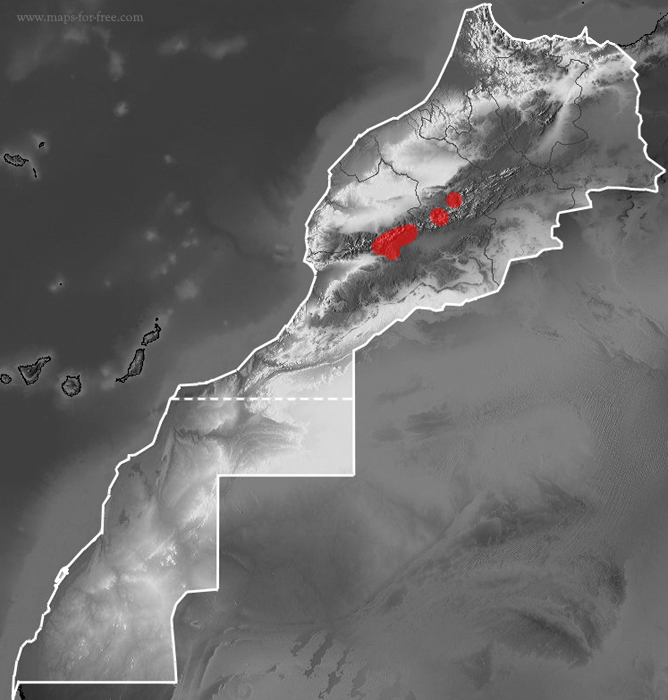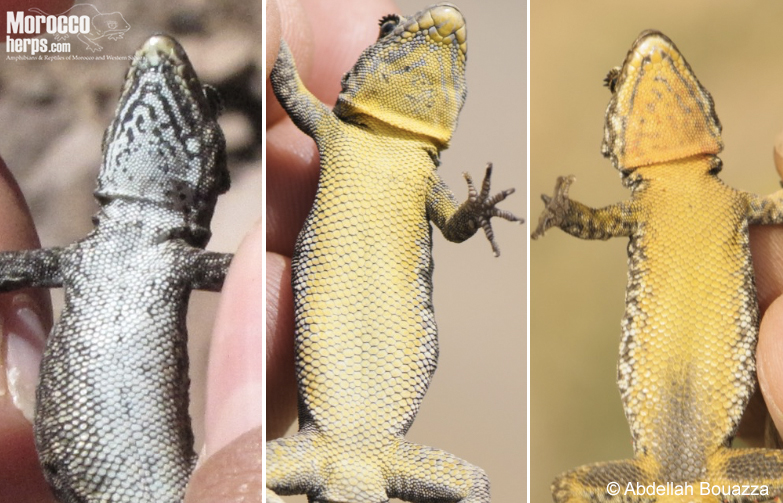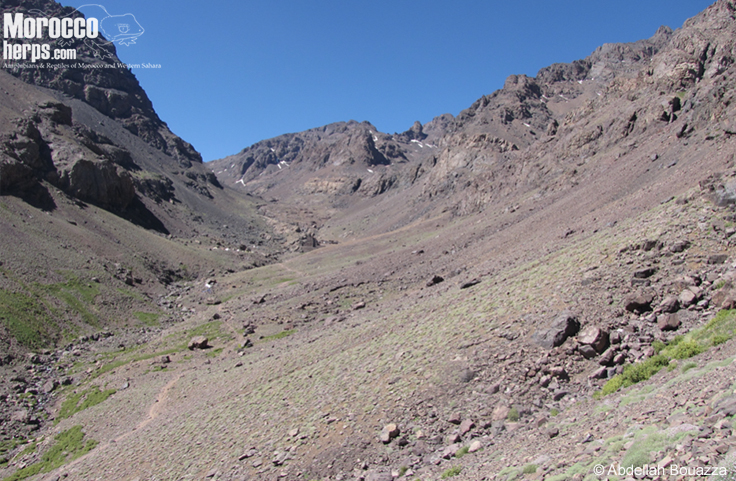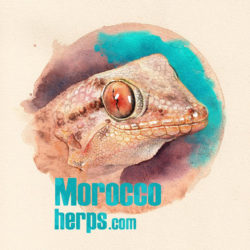High Atlas Day Gecko
Quedenfeldtia trachyblepharus (Boettger, 1873)
By Abdellah Bouazza
Updated: 08/04/2020
Taxonomy: Gekkota | Sphaerodactylidae | Quedenfeldtia | Quedenfeldtia trachyblepharus


 Quedenfeldtia trachyblepharus
Quedenfeldtia trachyblepharus
Distribution map of
Quedenfeldtia trachyblepharus
in Morocco.
1) Phylogenetic frame
The genus Quedenfeltia Boettger (1883) (Atlas Day Gecko) is endemic to Morocco. There are two species described in this genus, Q. trachyblepharus (Bons, 1967) and Q. moerens (Arnold, 1990) although the genus was considered monotypic for a long time prior to Arnold (1990). Recent studies show that this Moroccan genus (Quedenfeldtia) is basal to the American Sphaerodactylidae family that diverged by vicariance and dispersal events after fragmentation of Gondwana (Gamble et al., 2011).
Quedenfeldtia moerens is found across a wide variety of habitats, from sea level to 3000 m in altitude, whereas Q. trachyblepharus occupies exclusively high mountain regions reaching from 1400 m up to 4000 m (Bons and Geniez, 1996; Schleich et al., 1996). Recent genetic analysis revealed high variation between two species (Barata et al., 2012 ; Harris et al., 2017).
2) Description
Quedenfeldtia trachyblepharus is a small (approximately 4.4 cm snout–vent length) high-altitude gecko with strictly diurnal habits. In high altitude, this species observed basking close to rock crevices, often communally. A clear dimorphism in coloration and head size exists, and it is therefore possible to identify gender by sight (Blouin-Demers et al., 2013). Gravid females show an enlargement of the abdomen and of the calcium storing endolymphatic glands located at the base of the throat. Dominant males normally have a reddish or yellowish head more evident during the mating period (Schleich et al., 1996).

This species is characterized by three throat colour variations: Orange, yellow, and white. Blouin-Demers et al. (2013) showed that orange males had relatively longer jaws than white or yellow males, and hypothesized that colour variation could signal dominance.

Quedenfeldtia trachyblepharus and Quedenfeldtia moerens are distinguished by both external and osteological characters (Arnould, 1990; Bons and Geniez, 1996; Barata et al., 2012; Blouin-Demers et al., 2013; see table below for summary).
| Q. trachyblepharus (Boettger 1874) | Q. moerens (Chabanaud 1916) | |
| Number of presacral vertebrae | Generally 24 or 25 | Generally 22 or 23 |
| Cloacal tubercle | Large and prominent | Small or absent |
| Sexual dichromatism | Accentuated | Little |
| Yellow ocellus on the borders | Absent | Present |
| Iris of the eye | Gray-brown | Red-brown |
3) Ecology and habits
In the High Atlas Mountains, Atlas day geckos occasionally remain active during the winter: on sunny days they run around on rocks surrounded by snow fields (Schleich et al., 1996; Bouazza, 2012). These geckos lives under extreme climatic conditions (Bouazza et al., 2016), and on cold winter days when air temperatures rise to above 3°C they start basking within a few minutes after the sun hits the vicinity of their retreats (Schleich et al., 1996; Bouazza pers. obs.).
They are oviparous, each female depositing multiple clutches (generally 1-3) between April and July in communal egg-laying sites. Mating begins in March and is frequently initiated by the male.

It feeds on many insects, especially small beetles (Carretero et al., 2006).
Their main predators are the Atlas dwarf viper (Vipera monticola) and the Southern smooth snake (Coronella girondica) (Schleich et al., 1996 ; Bouazza pers. obs). These snakes live amidst thorn cushions around the rocks inhabited by Quedenfeldtia.
4) Distribution, habitat and abundance
Q. trachyblepharus occurs on rocky faces, both near water and in dry places (Schleich et al., 1996). They use rocks and fissures (sandstone and granite) as refuges in the High Atlas Mountains.
This Moroccan endemic is found in mountainous areas from 1400 m to 4000 m (Bons and Geniez, 1996; Schleich et al., 1996). However, the exact distribution of this species is still unknown (Barata et al., 2012 ; Harris et al., 2017). Comas et al., ( 2014) showed a significant loss of physical condition as the number of competitors increased at low altitude in this gecko. This loss of body condition may be due to competition for food at lower altitudes, where trophic resources have to be partitioned within a richer community. In the High Atlas Mountains, endemic alpine reptile species, as Q. trachyblepharus, Atlantolacerta andreanszkyi, and Chalcides montanus, co-occur with other species that have broader ranges, including species from Eurasia together with species of Mediterranean and Ibero-Maghrebian ranges (Bons & Geniez, 1996; Schleich et al., 1996). Above 2500 m in altitude. The Atlas day gecko shares its habitat mainly with the lizard Atlantolacerta andreanszkyi and Podarcis vaucheri (Bons & Geniez, 1996; Bouazza pers. obs.). Nevertheless, populations below 2500 m must share the habitat with a greater diversity of other species as Podarcis vaucheri, Scelarcis perspicillata, Tarentola mauritanica, Psammodromus algirus, and also larger species such as Timon tangitanus and Agama impalearis (Bons & Geniez, 1996; Schleich et al., 1996). Also, there is a replacement of saurophagic snakes with altitude, with Malpolon monspessulanus at low altitudes and Vipera monticola and Coronella girondica at higher altitudes (Schleich et al., 1996; Bouazza pers. obs.).
They form isolated populations with high densities, approximately 3 geckos/m² in the High Atlas Mountains (Schleich et al., 1996, Bouazza pers. obs.).



This species has been ranked by IUCN as “Near Threatened” because its extent of occurrence is less than 20,000 km² in area, and its habitat is severely fragmented. The species nearly qualifies for vulnerable status, but it does not appear to be in decline (Joger, 2006).
Bibliography
- Arnold EN. 1990. The two species of Moroccan day-geckoes, Quedenfeldtia (Reptilia: Gekkonidae). Journal of Natural History 24, 757-762.
- Barata M, Perera A, Martínez-Freiría F, Harris DJ. 2012. Cryptic diversity within the Moroccan endemic day geckos Quedenfeldtia (Squamata: Gekkonidae): a multidisciplinary approach using genetic, morphological and ecological data. Biological Journal of the Linnean Society, 106, 828-850.
- Blouin-Demers G, Lourdais O, Bouazza A, Verreault C, El Mouden H, Slimani T. 2013. Patterns of throat colour variation in Quedenfeldtia trachyblepharus, a high-altitude gecko endemic to the High Atlas Mountains of Morocco. Amphibia Reptilia 34: 567–572.
- Boettger O. 1883. Die reptilien und amphibien von Marocco II. Travaux de lnstitut Scientifique Cherifien. Sbrie Zoologique, 18, 1-130.
- Bons J. 1967. Recherches sur la biogeographie et la biologie des amphibiens et des reptiles du Maroc. 321. Thèse doct. es-Sciences, Université de Montpellier, France.
- Bons J, Geniez P. 1996. Amphibiens et reptiles du Maroc (Sahara occidental compris). Atlas biogéographique. Barcelona. Asociación Herpetologica Espanola.
- Bouazza A, Slimani T, El Mouden H, Blouin-Demers G, Lourdais O. 2016. Thermal constraints and the influence of reproduction on thermoregulation in a high-altitude gecko (Quedenfeldtia trachyblepharus). J. Zool. 300: 36‑44.
- Comas M, Escoriza D, Moreno-Rueda G. 2014. Stable isotope analysis reveals variation in trophic niche depending on altitude in an endemic alpine gecko. Basic and Applied Ecology 15: 362–369.
- Gamble T, Bauer AM, Colli GR, Greenbaum E, Jackman TR, Vitt LJ, Simons AM. 2011. Coming to America: multiple origins of New World geckos. J. Evol. Biol., 24, 231-244.
- Harris DJ, Rosado D, Xavier R, Salvi D. 2017. New genetic lineages within Moroccan day geckos Quedenfeldtia (Sphaerodactylidae) revealed by mitochondrial and nuclear DNA sequence data. Amphibia-Reptilia 38: 97‑101.
- Schleich H, Kastle W, Kabisch K. 1996. Amphibians and Reptiles from North Africa. Königstein, Germany., Koeltz Scientific Publications.
To cite this page:
Abdellah Bouazza (2020): Quedenfeldtia trachyblepharus (Boettger, 1873). In: Martínez, G., León, R., Jiménez-Robles, O., González De la Vega, J. P., Gabari, V., Rebollo, B., Sánchez-Tójar, A., Fernández-Cardenete, J. R., Gállego, J. (Eds.). Moroccoherps. Amphibians and Reptiles of Morocco and Western Sahara.
Available from www.moroccoherps.com/en/ficha/quedenfeldtia_trachyblepharus/. Version 08/04/2020.
To cite www.morocoherps.com en as a whole:
Martínez, G., León, R., Jiménez-Robles, O., González De la Vega, J.P., Gabari, V., Rebollo, B., Sánchez-Tójar, A., Fernández-Cardenete, J.R., Gállego, J. (Eds.). Moroccoherps. Amphibians and Reptiles of Morocco and Western Sahara.
Available from www.moroccoherps.com.

